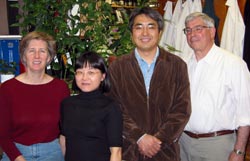Articles and reports from the Life Sciences and chemistry area deal with applied and basic research into modern biology, chemistry and human medicine.
Valuable information can be found on a range of life sciences fields including bacteriology, biochemistry, bionics, bioinformatics, biophysics, biotechnology, genetics, geobotany, human biology, marine biology, microbiology, molecular biology, cellular biology, zoology, bioinorganic chemistry, microchemistry and environmental chemistry.

The thymus, a once overlooked glandular structure just behind the top of the sternum, has gained increasing attention from scientists in the past two decades because it is where disease-fighting T-cells mature.
Especially in AIDS patients, T-cell count is a relative indicator of the body’s ability to fight disease. Until recently, however, researchers have understood little about how T-cells are generated.
Now, thanks to what a researcher at the University of Georgia calls a

Humans Share DNA That Helps Mice Move Ears, Eyes, Whiskers
University of Utah researchers have identified genes that ensure nerves develop in the correct part of the brain so mice can roll their eyeballs sideways, wiggle their whiskers, pull their ears back and blink their eyelids. The genes are common to all mammals, and so they likely help control human facial expressions such as smiles and frowns.
“In this study we looked at what nerves are made in a particular part of th

Duke University Medical Center researchers have linked elevated levels of a specific heart protein in elderly hearts to a decrease in the pumping ability of the heart.
Since levels of this protein, known as G-alpha-i, are also elevated in patients with congestive heart failure, the researchers believe that not only do they better understand why the heart’s pumping ability decreases with age, but that there may be a pharmacological approach to prevent this age-related decline.

A complete molecular-scale picture of how plants convert sunlight to chemical energy has been obtained at Purdue University, offering potential new insights into animal metabolism as well.
Using advanced imaging techniques, a team of Purdue biologists has determined the structure of the cytochrome, a protein complex that governs photosynthesis in a blue-green bacterium. While their work does not immediately suggest any industrial applications, it does reveal a wealth of information not onl

To the average person, the turkey genome may seem to be a lot of “gobbledygook.” But a just-published study in the journal, Genome, will help to ensure that the turkey that we “gobble down” at our Thanksgiving feasts will be a bird that is truly best of breed.
For the first time, researchers from the University of Minnesota and Nicholas Turkey Breeding Farms in California have collaborated to produce the first genome map, or genetic blueprint, of the domestic turkey (Meleagris gallopavo).

Scientists at the University of Pennsylvania have found a novel way to boost the paltry survival rate of cloned mammals: When two genetically identical cloned mouse embryos are combined, the aggregate embryo is considerably more likely to survive to birth.
A team from Penn’s School of Veterinary Medicine reports the results in the Oct. 1 issue of the European Molecular Biology Organization Journal.
“At the blastocyst stage, an early embryonic stage just prior to implantation,